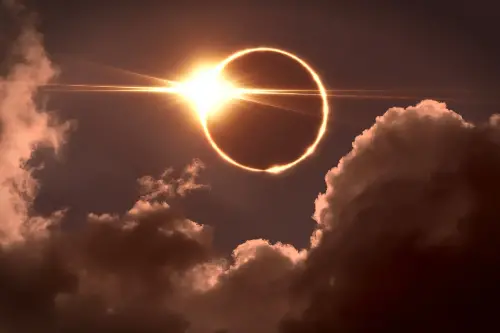Solar eclipses have captured the imagination of humanity for millennia. They are not merely celestial events but are profound spectacles in the tapestry of the skies—a dance of the cosmos where the moon veils the sun, turning day into twilight. As we delve into the wonders of solar eclipses, we uncover their types, occurrences, historical significance, and how to safely observe them.

The Enigmatic Types of Eclipses
Solar eclipses are categorised into four primary types: total, partial, annular, and hybrid. A total solar eclipse occurs when the sun is completely obscured by the moon, a rare event that requires an exact alignment of the Earth, moon, and sun. The sudden darkening of the sky during a total eclipse is a moment to behold, as it unveils the ethereal corona of the sun.
Partial solar eclipses are more common, witnessing the moon covering a portion of the sun. While not as dramatic as a total eclipse, the spectacle of a partial eclipse still provides a unique opportunity to observe our nearest star in a different light.
The annular solar eclipse occurs when the moon's apparent diameter is smaller than the sun's, causing the sun to appear as a blazing ring, often referred to as the 'ring of fire'. A hybrid eclipse is a rare phenomenon which transitions between a total and an annular eclipse along its path.
Patterns in the Skies: The Saros Cycle
The periodic nature of eclipses is governed by the Saros cycle, an 18-year, 11-day, and 8-hour period after which nearly identical eclipses occur. This ancient understanding, known since Babylonian astronomy, allows us to predict eclipses with remarkable precision.
Eclipses by the Numbers: Frequency and Location
Solar eclipses are relatively frequent occurrences with at least two and up to five eclipses happening each year. However, total solar eclipses are rare at any given location. On average, a total eclipse is observable from any one place on Earth about once every 360 years. The totality can last from a few seconds to a maximum of about seven and a half minutes, though this duration is very rare.
Solar eclipses are global events though their visibility is limited. The path of totality is typically a narrow track across the surface of the Earth. Observing a solar eclipse often requires travel to remote or specific locations to witness the full spectacle.
Historical Eclipses: Omens and Discoveries
Throughout history, solar eclipses have evoked awe and fear. Ancient civilisations often interpreted them as omens, prompting various myths and legends. Historical eclipses have also played pivotal roles in the development of science and history. For example, the Eclipse of Thales in 585 BCE is said to have halted a battle between the Medes and the Lydians when day turned unexpectedly to night.
In more recent history, the total solar eclipse of 1919 provided a crucial test for Albert Einstein's General Theory of Relativity. Observations during the eclipse supported his hypothesis that gravity could bend light, a turning point in modern physics.
Eye on the Eclipse: Safe Observation Practices
The importance of protecting your eyes during a solar eclipse cannot be overstressed. Observing the sun without proper safety equipment can cause severe eye damage or blindness. Never look directly at the sun without appropriate solar viewing glasses that meet international safety standards. Telescopes and binoculars require special solar filters.
During the brief phase of totality in a total solar eclipse, it is safe to look directly at the sun with the naked eye. However, at all other times, including during partial and annular eclipses, solar filters must be used.
Embracing the Eclipse Experience
Witnessing a solar eclipse is a profound experience, connecting us with the natural world and our place within the universe. Preparation is key to making the most of an eclipse. Local astronomy clubs and organisations often organise viewing events and provide educational resources.
Embrace the opportunity to be part of this celestial phenomenon. With the right preparation and an open heart, observing a solar eclipse can be a transformative experience, reminding us of the wonder that surrounds us and our eternal quest for understanding.
As we anticipate future eclipses, we do not merely await an astronomical event but a journey into the heart of darkness and back into light—a performance of celestial grace that continues to captivate and inspire.
